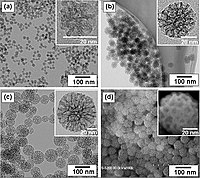
Photo from wikipedia
Abstract The triple-layered composite nanofiltration (NF) membrane consisting of thin polyamide (PA) top layer covered on polymeric porous membrane with interlayer has been popularly accepted, even commercially applied, to solve… Click to show full abstract
Abstract The triple-layered composite nanofiltration (NF) membrane consisting of thin polyamide (PA) top layer covered on polymeric porous membrane with interlayer has been popularly accepted, even commercially applied, to solve the “trade-off” issue. The nanofiltration performance was determined by the physicochemical properties of all layers. In the current work, hydroxyapatite (HAP) nanowires were adopted as a new type of interlayer material. Its superiority of ultra-hydrophilicity and electronegativity made it a container of aqueous monomers. As a result, ultra-thin and defect-free PA layer with a thickness of ~28 nm was generated owing to the low piperazine (PIP) concentration and restricted diffusion. In addition, the ultra-hydrophilic polysulfone (PSf) support layer was also helpful to reduce mass transfer resistance. The prepared PA/HAP/PSf composite membrane presented high salt aqueous solution permeation (177 L m−2 h−1 under 6 bar), excellent divalent salt rejection (98.2% for Na2SO4) and high mono/bivalent salt selectivity (19 for NaCl/Na2SO4 mixed solutions). This work proposed a useful strategy to construct highly permeable and selective NF membrane.
Journal Title: Colloids and Surfaces A: Physicochemical and Engineering Aspects
Year Published: 2021
Link to full text (if available)
Share on Social Media: Sign Up to like & get
recommendations!